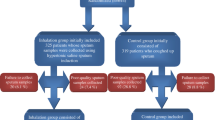Abstract
Sputum induction by the inhalation of hypertonic saline may increase the yield of microbiological diagnosis of pulmonary tuberculosis (TB). This is particularly relevant in paucibacillary TB, such as in children or human immunodeficiency virus (HIV)-infected patients. Sputum induction must be shown to be safe and tolerable in community settings where invasive diagnostic methods are unavailable. The objective of this study was to describe the changes in physiological parameters and adverse events occurring during sputum induction in ambulatory adult and adolescent TB suspects recruited in community clinics. Sputum induction was performed in HIV-infected (n = 35) and HIV-uninfected (n = 67) TB suspects (n = 102). Oxygen saturation (%), blood pressure (mm Hg), heart rate (/minute), respiratory rate (/minute), and adverse events were monitored at baseline, continuously during the salbutamol pre-treatment and saline nebulization phases, and for 30 min afterwards. During nebulization, there was a statistically significant increase in oxygen saturation (1%, p < 0.0001), systolic BP (7 mm Hg, p < 0.0001), and diastolic BP (2 mm Hg, p = 0.008). Post-nebulization decrease in the systolic BP occurred (4 mm Hg, p = 0.016). These changes were not considered to be clinically significant. Eight minor, transitory, self-resolving adverse events occurred (labored breathing, n = 2; chest pain, n = 2; paroxysmal coughing, n = 1; elevated heart rate, n = 1; vomiting, n = 1; hypotension, n = 1), leading to procedure termination in four participants. No serious adverse events occurred. Induced sputum is safe, tolerable, and feasible in adult and adolescent TB suspects in a community healthcare setting.





Similar content being viewed by others
References
Menzies D (2003) Sputum induction: simpler, cheaper, and safer—but is it better? Am J Respir Crit Care Med 167(5):676–677
Parry CM, Kamoto O, Harries AD, Wirima JJ, Nyirenda CM, Nyangulu DS, Hart CA (1995) The use of sputum induction for establishing a diagnosis in patients with suspected pulmonary tuberculosis in Malawi. Tuber Lung Dis 76(1):72–76
Hatherill M, Hawkridge T, Zar HJ, Whitelaw A, Tameris M, Workman L, Geiter L, Hanekom WA, Hussey G (2009) Induced sputum or gastric lavage for community-based diagnosis of childhood pulmonary tuberculosis? Arch Dis Child 94(3):195–201
Maher D, Harries A, Getahun H (2005) Tuberculosis and HIV interaction in sub-Saharan Africa: impact on patients and programmes; implications for policies. Trop Med Int Health 10(8):734–742
Mukadi YD, Maher D, Harries A (2001) Tuberculosis case fatality rates in high HIV prevalence populations in sub-Saharan Africa. AIDS 15(2):143–152
Palmieri F, Girardi E, Pellicelli AM, Rianda A, Bordi E, Rizzi EB, Petrosillo N, Ippolito G (2002) Pulmonary tuberculosis in HIV-infected patients presenting with normal chest radiograph and negative sputum smear. Infection 30(2):68–74
Aderaye G, Bruchfeld J, Assefa G, Feleke D, Källenius G, Baat M, Lindquist L (2004) The relationship between disease pattern and disease burden by chest radiography, M. tuberculosis load, and HIV status in patients with pulmonary tuberculosis in Addis Ababa. Infection 32(6):333–338
Liberato IR, de Albuquerque Mde F, Campelo AR, de Melo HR (2004) Characteristics of pulmonary tuberculosis in HIV seropositive and seronegative patients in a Northeastern region of Brazil. Rev Soc Bras Med Trop 37(1):46–50
Boehme CC, Nabeta P, Hillemann D, Nicol MP, Shenai S, Krapp F, Allen J, Tahirli R, Blakemore R, Rustomjee R, Milovic A, Jones M, O’Brien SM, Persing DH, Ruesch-Gerdes S, Gotuzzo E, Rodrigues C, Alland D, Perkins MD (2010) Rapid molecular detection of tuberculosis and rifampin resistance. N Engl J Med 363(11):1005–1015
Pizzichini E, Pizzichini MM, Leigh R, Djukanović R, Sterk PJ (2002) Safety of sputum induction. Eur Respir J Suppl 37:9s–18s
Wong HH, Fahy JV (1997) Safety of one method of sputum induction in asthmatic subjects. Am J Respir Crit Care Med 156(1):299–303
Fahy JV, Boushey HA, Lazarus SC, Mauger EA, Cherniack RM, Chinchilli VM, Craig TJ, Drazen JM, Ford JG, Fish JE, Israel E, Kraft M, Lemanske RF, Martin RJ, McLean D, Peters SP, Sorkness C, Szefler SJ; NHLBI Asthma Clinical Research Network (2001) Safety and reproducibility of sputum induction in asthmatic subjects in a multicenter study. Am J Respir Crit Care Med 163(6):1470–1475
de la Fuente PT, Romagnoli M, Godard P, Bousquet J, Chanez P (1998) Safety of inducing sputum in patients with asthma of varying severity. Am J Respir Crit Care Med 157(4 Pt 1):1127–1130
Castagnaro A, Chetta A, Foresi A, D’Ippolito R, Malorgio R, Olivieri D (1999) Effect of sputum induction on spirometric measurements and arterial oxygen saturation in asthmatic patients, smokers, and healthy subjects. Chest 116(4):941–945
Vlachos-Mayer H, Leigh R, Sharon RF, Hussack P, Hargreave FE (2000) Success and safety of sputum induction in the clinical setting. Eur Respir J 16(5):997–1000
Bathoorn E, Liesker J, Postma D, Koëter G, van Oosterhout AJ, Kerstjens HA (2007) Safety of sputum induction during exacerbations of COPD. Chest 131(2):432–438
Sutherland ER, Pak J, Langmack EL, Silkoff PE, Martin RJ (2002) Safety of sputum induction in moderate-to-severe chronic obstructive pulmonary disease. Respir Med 96(7):482–486
Dunleavy A, Breen RA, Perrin F, Lipman MC (2008) Is bronchodilation required routinely before diagnostic sputum induction? Evidence from studies with tuberculosis. Thorax 63(5):473–474
Paggiaro PL, Chanez P, Holz O, Ind PW, Djukanović R, Maestrelli P, Sterk PJ (2002) Sputum induction. Eur Respir J Suppl 37:3s–8s
Scheicher ME, Terra Filho J, Vianna EO (2003) Sputum induction: review of literature and proposal for a protocol. Sao Paulo Med J 121(5):213–219
Acknowledgments
H.D.G., W.K., N.B., M.T., and M.H. played significant roles in the collection of the data. All authors played a significant role in the planning, analysis, and manuscript preparation.
Funding
This work was supported by the National Institutes of Health (NIH/NIAID/DMID 1R01-AI075603-01). The authors declare that they have no conflict of interest.
Author information
Authors and Affiliations
Corresponding author
Rights and permissions
About this article
Cite this article
Geldenhuys, H.D., Kleynhans, W., Buckerfield, N. et al. Safety and tolerability of sputum induction in adolescents and adults with suspected pulmonary tuberculosis. Eur J Clin Microbiol Infect Dis 31, 529–537 (2012). https://doi.org/10.1007/s10096-011-1344-5
Received:
Accepted:
Published:
Issue Date:
DOI: https://doi.org/10.1007/s10096-011-1344-5




